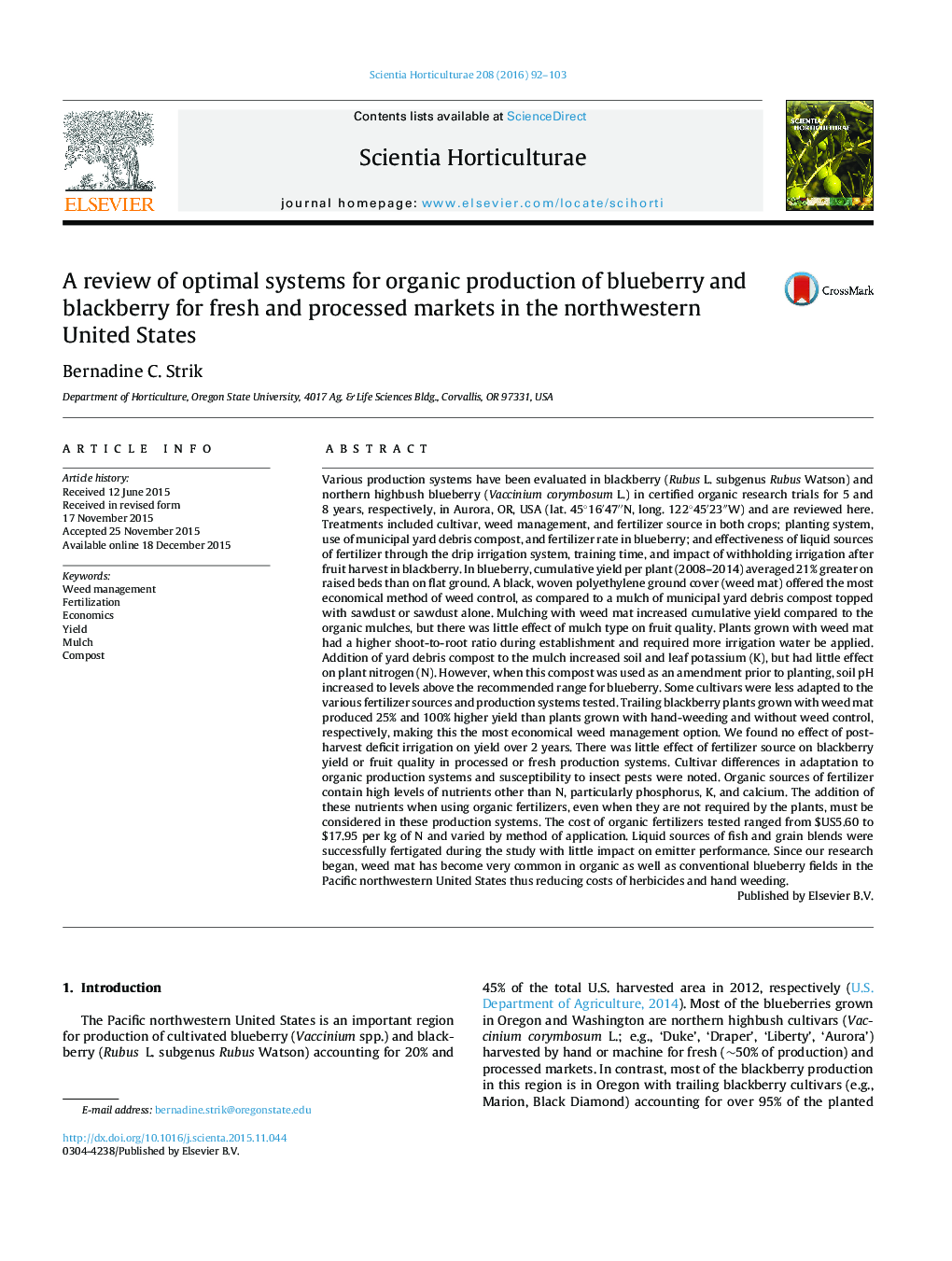| کد مقاله | کد نشریه | سال انتشار | مقاله انگلیسی | نسخه تمام متن |
|---|---|---|---|---|
| 6406284 | 1628790 | 2016 | 12 صفحه PDF | دانلود رایگان |

- The outcomes from various 5- and 8-year certified organic trials in blackberry and blueberry, respectively, are reviewed.
- Weed mat was the most economical method of weed control, but altered nutrient levels and irrigation requirement.
- High-pH municipal compost was effective when used as part of a mulch, but not as a pre-plant amendment in blueberry.
- Fertilizer source had little effect on yield and quality in blackberry, but was important for yield in blueberry cultivars.
- Treatments affected growth, yield, and economic returns; the best had yields similar to conventional production.
Various production systems have been evaluated in blackberry (Rubus L. subgenus Rubus Watson) and northern highbush blueberry (Vaccinium corymbosum L.) in certified organic research trials for 5 and 8 years, respectively, in Aurora, OR, USA (lat. 45°16â²47â³N, long. 122°45â²23â³W) and are reviewed here. Treatments included cultivar, weed management, and fertilizer source in both crops; planting system, use of municipal yard debris compost, and fertilizer rate in blueberry; and effectiveness of liquid sources of fertilizer through the drip irrigation system, training time, and impact of withholding irrigation after fruit harvest in blackberry. In blueberry, cumulative yield per plant (2008-2014) averaged 21% greater on raised beds than on flat ground. A black, woven polyethylene ground cover (weed mat) offered the most economical method of weed control, as compared to a mulch of municipal yard debris compost topped with sawdust or sawdust alone. Mulching with weed mat increased cumulative yield compared to the organic mulches, but there was little effect of mulch type on fruit quality. Plants grown with weed mat had a higher shoot-to-root ratio during establishment and required more irrigation water be applied. Addition of yard debris compost to the mulch increased soil and leaf potassium (K), but had little effect on plant nitrogen (N). However, when this compost was used as an amendment prior to planting, soil pH increased to levels above the recommended range for blueberry. Some cultivars were less adapted to the various fertilizer sources and production systems tested. Trailing blackberry plants grown with weed mat produced 25% and 100% higher yield than plants grown with hand-weeding and without weed control, respectively, making this the most economical weed management option. We found no effect of post-harvest deficit irrigation on yield over 2 years. There was little effect of fertilizer source on blackberry yield or fruit quality in processed or fresh production systems. Cultivar differences in adaptation to organic production systems and susceptibility to insect pests were noted. Organic sources of fertilizer contain high levels of nutrients other than N, particularly phosphorus, K, and calcium. The addition of these nutrients when using organic fertilizers, even when they are not required by the plants, must be considered in these production systems. The cost of organic fertilizers tested ranged from $US5.60 to $17.95 per kg of N and varied by method of application. Liquid sources of fish and grain blends were successfully fertigated during the study with little impact on emitter performance. Since our research began, weed mat has become very common in organic as well as conventional blueberry fields in the Pacific northwestern United States thus reducing costs of herbicides and hand weeding.
Journal: Scientia Horticulturae - Volume 208, 29 August 2016, Pages 92-103